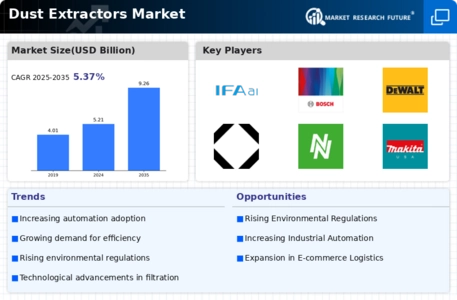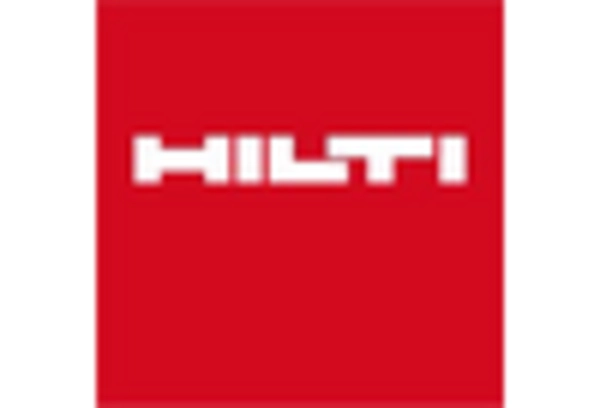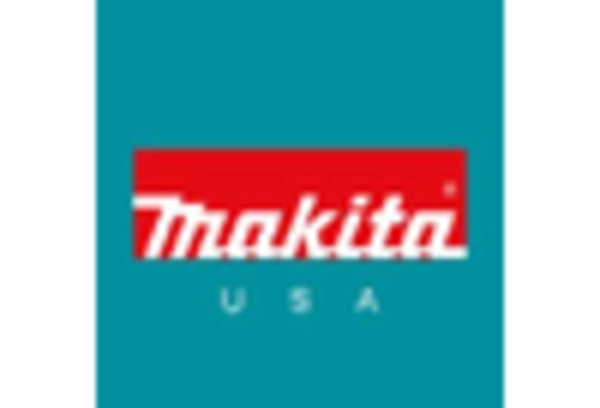Rising Health Awareness
Growing awareness regarding occupational health and safety is significantly influencing the Dust Extractors Market. As more organizations recognize the detrimental effects of dust exposure on workers' health, there is a heightened emphasis on implementing effective dust control measures. This trend is particularly evident in sectors such as construction and manufacturing, where dust-related health issues can lead to severe long-term consequences. The market for dust extractors is expected to expand as companies invest in advanced filtration technologies to protect their workforce. Recent statistics suggest that the global market for industrial air filtration systems, which includes dust extractors, is anticipated to reach USD 5 billion by 2026, reflecting a compound annual growth rate of approximately 4.2%. This growth underscores the increasing prioritization of health and safety in industrial environments.
Technological Innovations
Technological advancements in dust extraction systems are reshaping the Dust Extractors Market. Innovations such as smart dust extractors equipped with IoT capabilities and advanced filtration technologies are enhancing the efficiency and effectiveness of dust management solutions. These systems not only improve air quality but also offer real-time monitoring and data analytics, allowing businesses to optimize their operations. The integration of automation and artificial intelligence in dust extraction processes is expected to drive market growth, as companies seek to reduce operational costs and improve productivity. Furthermore, the introduction of energy-efficient models aligns with sustainability goals, making these technologies more appealing to environmentally conscious organizations. As a result, the market for technologically advanced dust extractors is likely to witness substantial growth in the coming years.
Increased Industrialization
The ongoing trend of industrialization across various sectors appears to be a primary driver for the Dust Extractors Market. As manufacturing processes expand, the need for effective dust management systems becomes increasingly critical. Industries such as construction, woodworking, and metalworking generate substantial amounts of dust and particulate matter, necessitating the implementation of dust extractors to ensure worker safety and compliance with health regulations. According to recent data, the manufacturing sector is projected to grow at a rate of 3.5% annually, which could lead to a corresponding increase in demand for dust extraction solutions. This growth indicates a robust market potential for dust extractors, as companies seek to enhance operational efficiency while adhering to safety standards.
Regulatory Standards and Compliance
The establishment of stringent regulatory standards regarding air quality and workplace safety is a significant driver for the Dust Extractors Market. Governments and regulatory bodies are increasingly enforcing laws that mandate the use of effective dust control measures in various industries. Compliance with these regulations is essential for companies to avoid penalties and ensure a safe working environment. As a result, businesses are investing in dust extraction systems to meet these legal requirements. The market is expected to grow as industries adapt to evolving regulations, particularly in sectors such as construction, manufacturing, and mining. Recent reports indicate that compliance-related investments in dust extraction technologies could increase by 20% over the next five years, highlighting the critical role of regulatory frameworks in shaping market dynamics.
Sustainability and Environmental Concerns
The rising focus on sustainability and environmental protection is driving the Dust Extractors Market. Companies are increasingly adopting eco-friendly practices, which include the implementation of efficient dust extraction systems to minimize environmental impact. The demand for sustainable dust extractors that utilize recyclable materials and energy-efficient technologies is on the rise. This shift is not only beneficial for the environment but also enhances corporate social responsibility initiatives. As industries strive to reduce their carbon footprint, the market for sustainable dust extraction solutions is expected to expand. Recent analyses suggest that the market for green technologies in industrial applications, including dust extractors, could grow by 15% annually, reflecting a broader trend towards sustainability in industrial operations.

















Leave a Comment